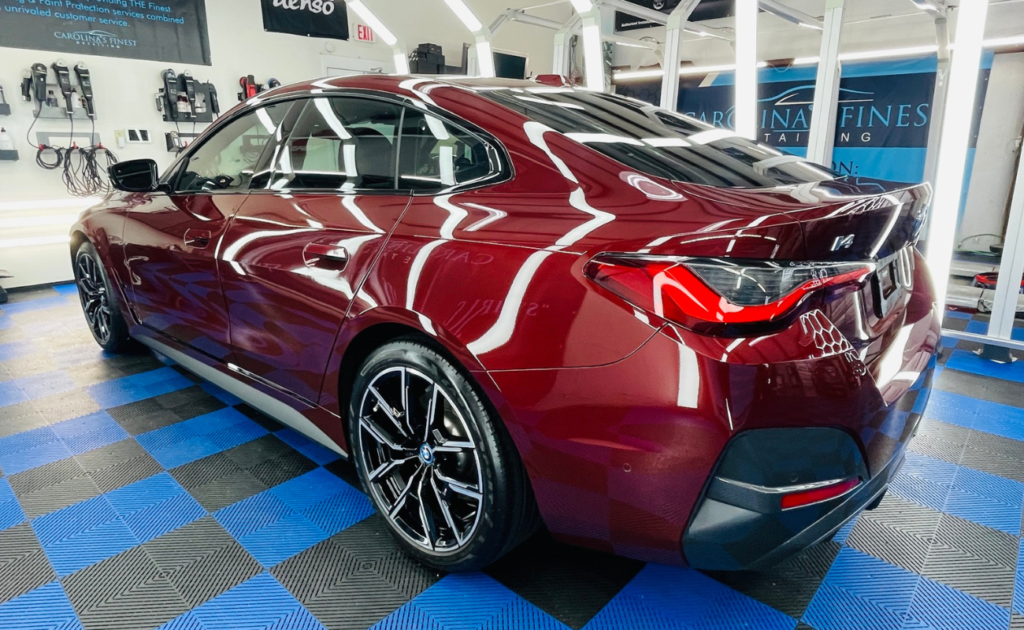Ceramic coatings can last up to 2-5 years with proper maintenance. Imagine the convenience of long-lasting protection for your vehicle’s paintwork. But how do you choose the right type of ceramic coating for your car? Understanding the benefits, application methods, and maintenance tips is crucial to making an informed decision. Let’s explore the world of ceramic coatings and discover how they can revolutionize how you care for your car.
Key Takeaways
- Benefits include durable protection, UV resistance, scratch resistance, hydrophobic properties, and enhanced gloss and shine.
- Types like SiO2, TiO2, and hybrid coatings offer varying benefits for superior protection and finish.
- Ceramic coating works by bonding a protective layer, preventing contaminants, oxidation, and UV damage.
- Application methods range from DIY to professional, with professional ceramic coating ensuring flawless finish and durability.
- Maintenance tips include gentle hand washing, avoiding abrasives, regular inspections, and reapplication every 1-2 years.
Benefits of Ceramic Coating
Ceramic coating offers unparalleled benefits for protecting your car’s paint. This solution provides a durable layer of protection that shields your vehicle from various environmental elements.
One key advantage of ceramic coating is its ability to resist contaminants like dirt, dust, and road grime. These substances adhere less easily to the coated surface, making cleaning your car and maintaining its pristine appearance easier.
Furthermore, the ceramic coating offers exceptional resistance to UV rays, which can cause paint to fade over time. By forming a protective barrier, the coating helps preserve the vibrant color of your vehicle’s paintwork, ensuring it looks newer for longer.
Additionally, this protective layer is highly hydrophobic, meaning it effectively repels water. This not only makes washing your car a breeze but also helps prevent water spots and mineral deposits from forming on the surface.
Moreover, the ceramic coating provides a high scratch resistance, helping keep your car looking flawless. It adds a layer of hardness to the paint, reducing the risk of scratches from everyday driving hazards.
Types of Ceramic Coatings
When choosing a ceramic coating for car, it’s essential to understand the benefits each type offers. Different coatings provide varying levels of protection against UV rays, chemicals, and scratches. Knowing the application methods for each type can help you select the best option for your vehicle’s needs.
Benefits of Coatings
Applying ceramic coatings to your car offers a range of benefits, with various types available to suit different needs and preferences. One key benefit is its protection against environmental contaminants such as bird droppings, UV rays, and harsh chemicals. Ceramic coatings create a protective layer that helps repel these substances, keeping your car’s paint fresh and vibrant for extended periods.
Additionally, these coatings offer superior scratch resistance compared to traditional waxes or sealants, helping maintain the appearance of your vehicle’s exterior.
Moreover, ceramic coatings provide hydrophobic properties, which means water and dirt are less likely to stick to the surface of your car, making it easier to clean and maintain. Some ceramic coatings also offer self-cleaning properties, where dirt and grime slide off with minimal effort.
Furthermore, these coatings can enhance the gloss and shine of your car, giving it a showroom finish that lasts for years.
Application Methods
Utilizing various application methods, ceramic coatings can be classified into different types based on their composition and bonding mechanisms. The most common types are SiO2 (silicon dioxide) coatings, TiO2 (titanium dioxide) coatings, and hybrid coatings.
SiO2 coatings use silicon dioxide nanoparticles to create a durable protective layer on the car’s surface. TiO2 coatings incorporate titanium dioxide particles, known for their UV-resistant properties, offering excellent protection against oxidation and fading. Hybrid coatings combine the benefits of both SiO2 and TiO2 coatings, providing a robust shield against environmental contaminants and UV rays.
Each type of coating has its unique application method, such as spray-on, wipe-on, or professional application. Spray-on coatings are popular for their ease of use and even coverage, while wipe-on coatings require meticulous application but can achieve excellent results when applied correctly. Professional application methods involve trained technicians applying the coating using specialized tools and techniques, ensuring a flawless finish and maximum durability for your car’s protection.
How Ceramic Coating Works
When it comes to ceramic coating for your car, understanding how it works is crucial. The benefits of ceramic coating lie in its ability to provide long-lasting protection against environmental elements and minor scratches.
The application process involves careful preparation and meticulous layering to ensure durability and a showroom shine.
Ceramic Coating Benefits
A ceramic coating for your car provides a protective layer that bonds to the surface, enhancing its durability and appearance. This coating is a barrier against environmental contaminants and prevents oxidation and corrosion. By forming a semi-permanent bond with the paintwork, ceramic coatings offer long-lasting protection that traditional waxes and sealants can’t match.
One critical benefit of ceramic coating is its hydrophobic properties. Water beads up and rolls off the surface, carrying dirt and grime. This feature makes your car easier to clean and maintain, reducing the frequency of washing while keeping it looking fresh.
Additionally, ceramic coatings provide UV protection, preventing the sun’s rays from fading your car’s paint over time. The enhanced gloss and color depth achieved with a ceramic coating give your vehicle a showroom finish that lasts for years.
Application Process
Applying a ceramic coating to your car involves thorough surface preparation to ensure optimal adhesion. Before application, the car must be washed and decontaminated to remove any dirt, grime, or residue that could interfere with the bonding of the ceramic coating.
Next, any imperfections, such as scratches or swirl marks, should be corrected through polishing. Once the surface is clean and smooth, the ceramic coating is carefully applied in small sections using an applicator pad or cloth. It is important to follow the manufacturer’s instructions regarding curing times and environmental conditions during application.
After the coating is evenly applied, it needs time to cure and bond with the paint, creating a protective layer that enhances the gloss and shields the car’s surface from environmental contaminants. Proper application ensures the ceramic coating adheres effectively, providing long-lasting protection for your vehicle’s paintwork.
Durability and Protection
The durability and protection provided by ceramic coatings stem from their chemical composition and bonding properties. Ceramic coatings contain silicon dioxide (SiO2) and titanium dioxide (TiO2) nanoparticles that create a strong protective layer on the surface of your car. When applied correctly, these nanoparticles form a covalent bond with the paint, creating a semi-permanent barrier that resists UV rays, chemicals, dirt, and other contaminants. This bond ensures the coating doesn’t wash away or break down easily, providing long-lasting protection for your vehicle’s paintwork.
Moreover, the hydrophobic nature of ceramic coatings repels water and prevents contaminants from bonding to the surface, making it easier to clean and maintain your car’s appearance.
The hardness of the ceramic coating also adds a layer of scratch resistance, helping to preserve your vehicle’s finish.

DIY Vs. Professional Application
Whether to apply ceramic coating to your car yourself or hire a professional requires careful evaluation of your skills, time, and resources.
DIY application can be a cost-effective option if you have experience with detailing and are confident in your abilities. However, applying ceramic coating correctly requires meticulous preparation, including thorough cleaning, paint correction, and precise application techniques.
Professionals, on the other hand, have the expertise and tools to ensure a flawless finish. They can assess your car’s condition, choose the best ceramic coating product, and apply it with precision. Professional application typically results in a more uniform and durable coating that can last longer than a DIY job.
If you opt for a DIY approach, be prepared to invest time and effort in researching the process, gathering the necessary supplies, and practicing your technique. Mistakes during application can lead to uneven coverage, streaks, or premature wearing of the coating.
On the other hand, hiring a professional may cost more initially but can save you time and frustration while providing a higher level of expertise and quality assurance.
Ultimately, the decision between DIY and professional application depends on your comfort level, time availability, and budget. Whether you choose to tackle the project yourself or entrust it to a professional, ceramic coating can enhance the appearance and protection of your car’s paint for years to come.
Maintenance Tips for Ceramic Coating
When maintaining a ceramic coating on your car, regular care and attention are essential to ensure its longevity and effectiveness. To keep your ceramic coating looking its best, follow these maintenance tips:
- Hand Wash Only: Avoid automatic car washes that use harsh chemicals or stiff brushes. Instead, opt for gentle hand washing with a pH-neutral car wash soap and a soft microfiber wash mitt to prevent scratching the coating.
- Avoid Abrasive Materials: When drying your car after washing, use a clean microfiber drying towel to prevent swirl marks. Avoid using rough materials like sponges or dirty towels that can damage the coating.
- Regular Inspections: Periodically inspect your ceramic coating for any signs of damage or wear. Look for water beading and sheeting properties to ensure the coating is still effective. If you notice any issues, consider applying a ceramic coating maintenance spray to rejuvenate the coating.
- Avoid Harsh Chemicals: Refrain from using strong detergents, solvents, or acidic cleaners on your coated car. These can degrade the coating and reduce its protective properties.
- Reapply as Needed: Depending on the quality of the initial application and your driving conditions, you may need to reapply the ceramic coating every 1-2 years to maintain optimal protection.
FAQS About Ceramic Coating
Interested in learning more about ceramic coating for your car? Here are some frequently asked questions to help you understand this popular car protection solution better:
- What is ceramic coating? Ceramic coating is a liquid polymer applied to the exterior of a vehicle. It chemically bonds with the vehicle’s factory paint, creating a protective layer.
- How long does ceramic coating last? The durability of ceramic coating can vary depending on the brand and quality of the product used. Typically, it can last anywhere from 2 to 5 years with proper maintenance.
- Is ceramic coating scratch-proof? While ceramic coating offers excellent scratch resistance, it isn’t completely scratch-proof. It can help protect your car’s paint from light scratches and swirl marks.
- Can I apply ceramic coating myself? While DIY ceramic coating kits are available, for best results, it’s recommended to have a professional apply the coating. Professionals have the expertise and tools to ensure proper application and durability.
Understanding these common questions about ceramic coating can help you make an informed decision about whether it’s the right choice for your car.
Ceramic coating is like a shield for your car, protecting it from the elements and keeping it looking pristine. Just like how a knight’s armor defends against enemy attacks, ceramic coating defends against scratches, UV rays, and contaminants. By choosing the right type of coating and following proper maintenance tips, you can ensure your vehicle stays in top condition for years to come. So, armor up your car with ceramic coating and let it shine like a true champion on the road.
